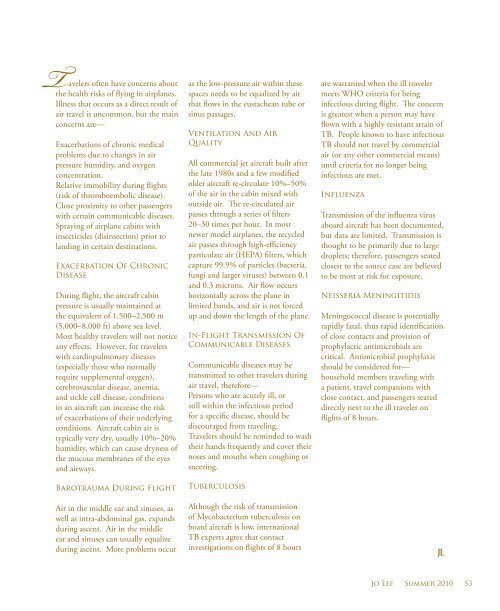Summer 2010 Jo Lee - JO LEE Magazine
Summer 2010 Jo Lee - JO LEE Magazine
Summer 2010 Jo Lee - JO LEE Magazine
You also want an ePaper? Increase the reach of your titles
YUMPU automatically turns print PDFs into web optimized ePapers that Google loves.
Tavelers often have concerns about<br />
the health risks of flying in airplanes.<br />
Illness that occurs as a direct result of<br />
air travel is uncommon, but the main<br />
concerns are—<br />
Exacerbations of chronic medical<br />
problems due to changes in air<br />
pressure humidity, and oxygen<br />
concentration.<br />
Relative immobility during flights<br />
(risk of thromboembolic disease).<br />
Close proximity to other passengers<br />
with certain communicable diseases.<br />
Spraying of airplane cabins with<br />
insecticides (disinsection) prior to<br />
landing in certain destinations.<br />
Exacerbation Of Chronic<br />
Disease<br />
During flight, the aircraft cabin<br />
pressure is usually maintained at<br />
the equivalent of 1,500–2,500 m<br />
(5,000–8,000 ft) above sea level.<br />
Most healthy travelers will not notice<br />
any effects. However, for travelers<br />
with cardiopulmonary diseases<br />
(especially those who normally<br />
require supplemental oxygen),<br />
cerebrovascular disease, anemia,<br />
and sickle cell disease, conditions<br />
in an aircraft can increase the risk<br />
of exacerbations of their underlying<br />
conditions. Aircraft cabin air is<br />
typically very dry, usually 10%–20%<br />
humidity, which can cause dryness of<br />
the mucous membranes of the eyes<br />
and airways.<br />
Barotrauma During Flight<br />
Air in the middle ear and sinuses, as<br />
well as intra-abdominal gas, expands<br />
during ascent. Air in the middle<br />
ear and sinuses can usually equalize<br />
during ascent. More problems occur<br />
as the low-pressure air within these<br />
spaces needs to be equalized by air<br />
that flows in the eustachean tube or<br />
sinus passages.<br />
Ventilation And Air<br />
Quality<br />
All commercial jet aircraft built after<br />
the late 1980s and a few modified<br />
older aircraft re-circulate 10%–50%<br />
of the air in the cabin mixed with<br />
outside air. The re-circulated air<br />
passes through a series of filters<br />
20–30 times per hour. In most<br />
newer model airplanes, the recycled<br />
air passes through high-efficiency<br />
particulate air (HEPA) filters, which<br />
capture 99.9% of particles (bacteria,<br />
fungi and larger viruses) between 0.1<br />
and 0.3 microns. Air flow occurs<br />
horizontally across the plane in<br />
limited bands, and air is not forced<br />
up and down the length of the plane.<br />
In-Flight Transmission Of<br />
Communicable Diseases<br />
Communicable diseases may be<br />
transmitted to other travelers during<br />
air travel, therefore—<br />
Persons who are acutely ill, or<br />
still within the infectious period<br />
for a specific disease, should be<br />
discouraged from traveling.<br />
Travelers should be reminded to wash<br />
their hands frequently and cover their<br />
noses and mouths when coughing or<br />
sneezing.<br />
Tuberculosis<br />
Although the risk of transmission<br />
of Mycobacterium tuberculosis on<br />
board aircraft is low, international<br />
TB experts agree that contact<br />
investigations on flights of 8 hours<br />
are warranted when the ill traveler<br />
meets WHO criteria for being<br />
infectious during flight. The concern<br />
is greatest when a person may have<br />
flown with a highly resistant strain of<br />
TB. People known to have infectious<br />
TB should not travel by commercial<br />
air (or any other commercial means)<br />
until criteria for no longer being<br />
infectious are met.<br />
Influenza<br />
Transmission of the influenza virus<br />
aboard aircraft has been documented,<br />
but data are limited. Transmission is<br />
thought to be primarily due to large<br />
droplets; therefore, passengers seated<br />
closest to the source case are believed<br />
to be most at risk for exposure.<br />
Neisseria Meningitidis<br />
Meningococcal disease is potentially<br />
rapidly fatal, thus rapid identification<br />
of close contacts and provision of<br />
prophylactic antimicrobials are<br />
critical. Antimicrobial prophylaxis<br />
should be considered for—<br />
household members traveling with<br />
a patient, travel companions with<br />
close contact, and passengers seated<br />
directly next to the ill traveler on<br />
flights of 8 hours.<br />
JL<br />
<strong>Jo</strong> <strong>Lee</strong> <strong>Summer</strong> <strong>2010</strong> 53
















